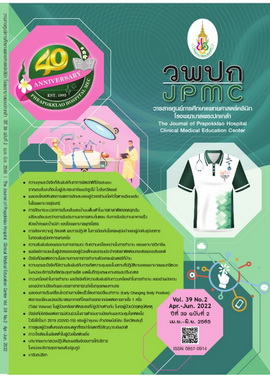The Prevalence and Associated Factors of Workplace Violence among Nurses in Psychiatric Centers of the Department of Mental Health in Bangkok and Its Vicinity
Main Article Content
Abstract
BACKGROUND: Workplace violence is one of the most important problems in hospitals. This form of violence has been shown to have a negative impact on workers’ health, safety, and productivity. As a result, this could lead to resignation, permanent disability, or death. Even though psychiatric departments frequently encounter violent incidents, related studies are still limited.
OBJECTIVES: To investigate the prevalence and associated factors of workplace violence among nurses in psychiatric centers of the Department of Mental Health in Bangkok and its vicinity.
METHODS: The research design was a cross-sectional descriptive study. The samples, obtained from stratified sampling and simple random sampling, comprised 279 psychiatric nurses. The prevalence and associated factors of workplace violence were assessed by a self-administered questionnaire in a Thai language version. The data were analyzed with descriptive statistics and multiple logistic regression.
RESULTS: The one-year prevalence of workplace violence in psychiatric nurses was 54.5%. Among this, verbal violence was the most common (90.1%), followed by physical violence (38.2%), and sexual violence (10.5%), respectively. The perpetrators who committed most of the violence were patients. The associated factors of workplace violence consisted of having a moderate or severe to extremely severe level of anxiety, working in the Outpatient Department, having a history of hospital violence and being in an overcrowded environment.
CONCLUSIONS: The prevalence of workplace violence among psychiatric nurses was quite high. Therefore, the prevention of violence should be enhanced by focusing on those departments with frequent violence or hospitals with histories of violence. In addition, adjusting the work area to reduce overcrowdedness, assessing personnel mental health, and instilling trust in workplace safety should be investigated and implemented.
Article Details

This work is licensed under a Creative Commons Attribution-NonCommercial-NoDerivatives 4.0 International License.
References
The National Institute for Occupational Safety and Health. Violence occupational hazards in hospitals [Internet]. 2014 [cited 2020 Sep 12]. Available from: https://www.cdc.gov/niosh/docs/2002-101/default.html
U.S. Bureau of Labor Statistics. Workplace violence in healthcare, 2018 [Internet]. 2020 [cited 2020 Sep 15]. Available from: https://www.bls.gov/iif/oshwc/cfoi/workplace-violence-healthcare-2018.htm
Heckemann B, Zeller A, Hahn S, Dassen T, Schols JM, Halfens RJ. The effect of aggression management training programmes for nursing staff and students working in an acute hospital setting. a narrative review of current literature. Nurse Educ Today 2015;35:212-9.
Lu L, Lok KI, Zhang L, Hu A, Ungvari GS, Bressington DT, et al. Prevalence of verbal and physical workplace violence against nurses in psychiatric hospitals in China. Arch Psychiatr Nurs 2019;33(5):68-72.
Kobayashi Y, Oe M, Ishida T, Matsuoka M, Chiba H, Uchimura N. Workplace violence and Its effects on burnout and secondary traumatic stress among mental healthcare nurses in Japan. Int J Environ Res Public Health [Internet]. 2020 [cited 2021 Feb 2];17(8):2747. Available from: https://www.mdpi.com/1660-4601/17/8/2747#stats_id
Kayai N. Workplace violence among nurses at a psychiatric hospital [dissertation] Chiang Mai: Chiang Mai university; 2006.
Khoshknab MF, Tamizi Z, Ghazanfari N, Mehrabani G. Prevalence of workplace violence in psychiatric wards, Tehran, Iran. Pak J Biol Sci 2012;15:680-4
Itzhaki M, Bluvstein I, Peles Bortz A, Kostistky H, Bar Noy D, Filshtinsky V, et al. Mental health nurse's exposure to workplace violence leads to job stress, which leads to reduced professional quality of life. Front Psychiatry [Internet]. 2018 [cited 2020 Nov 27];9:59. Available from: https://www.frontiersin.org/articles/10.3389/fpsyt.2018.00059/full
Basfr W, Hamdan A, Al-Habib S. Workplace violence against nurses in psychiatric hospital settings: perspectives from Saudi Arabia. Sultan Qaboos Univ Med J [Internet]. 2019 [cited 2020 Nov 27];19(1):e19-e25. Available from: https://www.ncbi.nlm.nih.gov/pmc/articles/PMC6544070/
Piquero NL, Piquero AR, Craig JM, Clipper SJ. Assessing research on workplace violence, 2000–2012. Aggression and violent behavior 2013;18:383-94.
Patcharatanasan N, Lertmaharit S. The prevalence characteristic and related factors of workplace violence in healthcare workers in emergency departments of government hospitals in region 6 health provider. Journal of Preventive Medicine Association of Thailand 2018;8:212-25.
ILO,ICN,WHO, PSI. International Labor Office, International Council of Nurses, World Health Organization, Public Services International. Workplace violence in the health sector country case studies research instruments survey questionnaire [Internet]. Geneva: WHO; 2003. [cited 2020 Nov 27]. Available from: https://www.who.int/docs/default source/documents/violence-against-health-workers/wvquestionnaire.pdf?sfvrsn=9f6810a5_2
Jiao M, Ning N, Li Y, Gao L, Cui Y, Sun H, et al. Workplace violence against nurses in Chinese hospitals: a cross-sectional survey. BMJ Open [Internet]. 2015 [cited 2020 Nov 27];26;5(3):e006719. Available from: https://bmjopen.bmj.com/content/5/3/e006719.long
Pekurinen V, Willman L, Virtanen M, Kivimäki M, Vahtera J, Välimäki M. Patient aggression and the wellbeing of nurses: a cross-sectional survey study in psychiatric and non-psychiatric settings. Int J Environ Res Public Health [Internet]. 2017[cited 2020 Nov 27];14 (10):1245. Available from: https://www.mdpi.com/1660-4601/14/10/1245
Daseh A, Obaid O. Workplace violence: patient’s against staff nurse in mental health care setting. Journal of Natural Sciences Research.2017;7(24):88-95.

